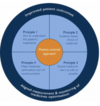Lectures Flashcards
(56 cards)
When was the Nurses Prescribing Formularly created?
1992
What years were pharmacists able to train as supplementary prescribers, and then independent prescribers?
Supplementary –> 2002
Independent –> 2006

What are the 3 key principles about supplementary prescribing?
Importance of communication between prescribing partners
The need of access to shared patient records
The patient is involved in all stages of prescribing, regadless of who does it
What is the main difference between a supplementary prescriber and an indepedent one?
Supplementary –> Works within a clinical mamagment plan (CMP)
Indepedent –> Operates within their own competence

What are the 2 domains of the prescribing competency framework?
The Consultation
Prescribing Governance

What’s the difference between criminal and civil law?
Criminal –> Breaking of the law
Civil –> Breach of duty of care to a patient (‘tort’)
What’s the difference between Utilitarianism and Deontological thinking?
Utilitarianism –> For the many people, not the few
Deontological –> Shouldn’t cause harm to anyone full stop
What are the 2 different types of clincal decision making?
Selective –> Options already exist, and we need to select the best one
Creative –> Need to generate options from gained information
- These decisions can inbolve our own emotions and bias…so can be more risky

What is the most common reason for clincal errors?
Errors of reasoning or decision quality

What is the Six Stage Approach?

What is the difference Analytic and Non-Analytic reasoning?
Analytic –> Gathering and weighing of elicited data against mental rules
- Often linked to the evidence base
Non-Analytic –> Use of past-experiences more (eg, compairing past patients to the current patient)
- Often increase with experience
- Rapid/unconcious analysis
What are the possible reasons for not monitoring somebody?
Inconvenience
Cost
Impact of possible fake-positives/negatives
Age (is the renal function of a frail elderly women really important?)
What are the benefits and negatives of self-monitoring?
Benefits –> Can be motivational, can prevent the number of clinician visits (eg, home BP monitoring), to adjust therapy (eg, insulin levels)
Negatives –> Can increase patient anxiety (meaning small changes will cause them to run to their GP!)
When are ADRs most likely to occur?
As the start of treatment or dose increases
What 5 things should we think about when designing a monitoring strategy?
Whether to monitor at all!
Choice of measurment(s)
Choice of a target range
Choice of measurment intervals
Who should do the monitoring
Define Leadership
The action of leading a group of people or an organisation, or the ability to do this
What are the 5 different types of leadership style?
Autocratic –> Makes decisions with no input from others
Paternalism –> Whilst they consult, ultimatly they make the decision themselves
Consultative –> Good connection between themselves and staff to come to agreements (requires high inter-personal skills)
Democratic –> Listens to others perspectives and uses that information to guide his decision (can take longer)
Laissez-Faire –> Hands-off approach, little contact with anyone and lack of decision making

What are the 4 domains of situational leadership?
Different leadership styles are often needed for different people in different situations
Supporting/Delegating –> Develops team-members abilities to work independently
Coaching/Directing –> Focused on getting the job done

What is the Healthcare Leadership Model?

Define Frailty
A state assocaited with low energy, slow walking speed and poor strength
or
A state of increased vulnerability to poor resolution of homeostasis after a stressor event

What is the most common diagnositc test of frailty?
The 4m walking speed test

Define Medicines Optimisation
An outcome focussed approach to safe and effective use of medicines that takes into account the patients values, perceptions and experience of taking their medication
What are the 4 levels of medication review?
0 –> An opportunisitc review out of nowhere
1 –> Prescription review
2 –> Treatment review (with full patient notes)
3 –> Full review with patient, notes and prescription history
In terms of medication reviews, what is the acronym SWAN?
Safety
Working well
Appropriate
National Guidance


















